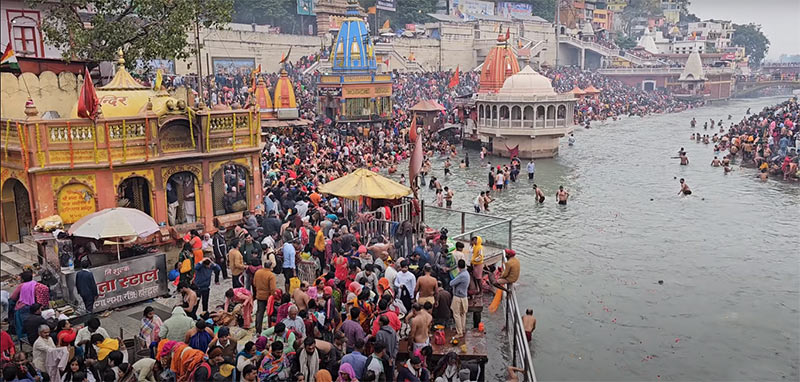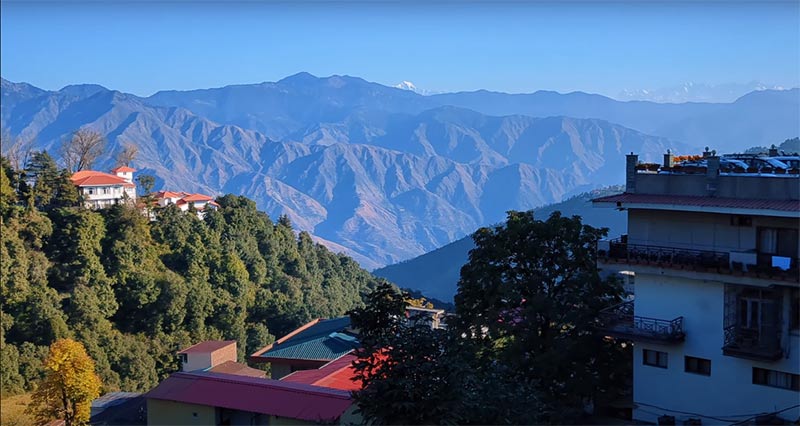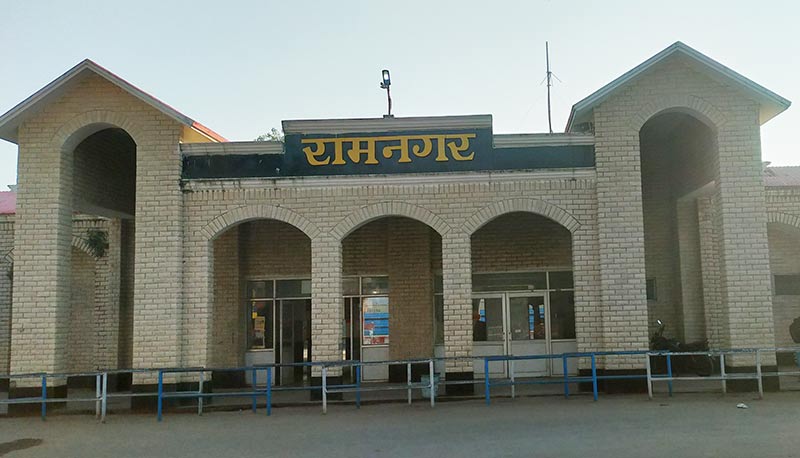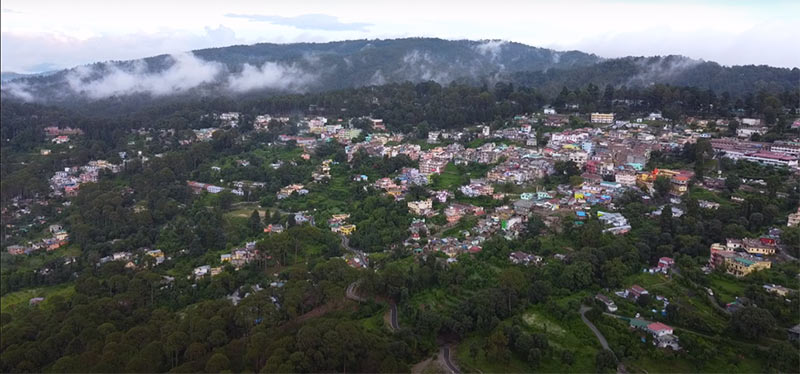Haridwar, located in Uttarakhand, stands among the seven holiest cities in India and holds immense religious significance. Positioned at the juncture where the sacred Ganga enters the Indo-Gangetic plains, Haridwar is adorned with temples, ashrams, and labyrinthine lanes, attracting millions of Hindu devotees. A pivotal ritual involves taking a dip in the holy Ganges at Har Ki Pauri, believed to absolve individuals of their sins.

The city’s hallmark event is the renowned Ganga Aarti, a daily ritual conducted at the Har ki Pauri Ghat each evening. This spectacle draws thousands of devotees who gather to offer prayers to the river Ganga and release illuminated diyas onto its waters. Haridwar, hosting the Kumbh Mela every twelve years alongside Ujjain, Nasik, and Allahabad, is also the annual venue for the Kanwar Mela during the rainy season.
Haridwar serves as the gateway to Uttarakhand’s Char Dham and serves as a base for neighboring tourist destinations like Rishikesh and Devprayag. The city encompasses the Panch Tirth (five pilgrimages), comprising Har ki Pauri (Gangadwar), Ghat (Kushwart), Kankhal, Mansa Devi Temple (Bilwa Tirth), and Chandi Devi Temple (Neel Parvat).
Beyond its religious prominence, Haridwar is globally recognized for Ayurveda, meditation, and yoga. Due to its spiritual character, the consumption of alcohol and non-vegetarian food is restricted. The city maintains robust connectivity through buses and trains, though it experiences heightened activity during the yatra season from May to October. Haridwar thus stands as a sanctified destination, weaving together tradition, spirituality, and cultural fervor.
Ramnagar is also a popular tourist destination in Uttarakhand; you can also learn more about it
Historical Overview of Haridwar
Archaeological Insights:
Haridwar, situated in Uttarakhand, boasts a rich history supported by archaeological findings, indicating the existence of a terracotta culture as far back as 1700 B.C. to 1800 B.C. The city has been a constant presence in historical narratives, spanning from the era of Buddha to the British arrival and continuing its significance into the 21st century.
Imperial Rule and Noteworthy Visitors:
Under the reign of the Maurya Empire from 322 BCE to 185 BCE, Haridwar evolved as a significant center. Later, it fell under the rule of the Kushan Empire. The city’s historical tapestry includes a visit by the renowned Chinese traveler Huan Tsang in 629 AD, during the rule of King Harshvardhan.
Invasions and Mughal Era:
Haridwar faced invasions, notably by Timur Lang in 1399. Subsequently, in the 16th century, it came under the dominion of the Mughals, with emperors like Akbar and Jehangir leaving their mark. The Ain-e-Akbari records Akbar drinking water from the Ganges River at Haridwar, referring to it as ‘the water of immortality.
European Exploration and Infrastructure Development:
English traveler Thomas Coryat visited Haridwar during Jehangir’s rule, and by the 18th century, the city became a port city extensively used by the East India Company’s ships. The Bhimgoda Dam, one of the major dams on the Ganges, was opened in 1854. Haridwar Municipality was established in 1868, and rail connectivity was introduced with the Laksar Railway Station in 1886.
Demographic Shifts and Educational Institutions:
In 1901, Haridwar’s population was recorded at 25,597, and by 1902, Gurukul Kangri Vishwavidyalaya, an educational institution, was established. In 1946, Haridwar was merged into the state of Uttar Pradesh.
Legends and Spiritual Significance:
According to ancient Indian scriptures, Haridwar is mentioned as Mayapur, Kapilsthan, Mokshdwar, or Gangadwar. The city holds a special place in Hindu mythology, with legends such as King Bhagirath’s penance to bring the Ganga from heaven and the presence of all three major Gods, Brahma, Vishnu, and Mahesh.
Pilgrimages and Genealogy Records:
Haridwar is recognized for Panch Tirth and the legendary Har Ki Pauri. It is believed that nectar (Amrit) from the sea churning was sprinkled at Har-Ki-Pauri, making it a significant pilgrimage site. The city’s pandits meticulously maintain genealogy records, known as vahis, providing an extensive repository of family trees in North India.
Religious Festivals and the Kumbh Mela:
Haridwar hosts the Ardha Kumbha Mela every six years and the Kumbh Mela every twelve years, attracting pilgrims who believe in the city’s sanctifying power and the salvation offered by the Ganges waters.
Haridwar, with its multifaceted history, remains a testament to the confluence of ancient mythology and the evolution of a modern urban center.
Key Features and Etiquettes in Haridwar
Temple Visits and Etiquettes:
Haridwar boasts several temples that attract visitors year-round. It’s important to note that wearing shoes is prohibited in all temples within the city. The spiritual ambiance of these sacred places contributes to the reverence maintained by adhering to this practice.
City Overview:
Spanning over 12.3 square kilometers, Haridwar stands at an altitude of 315 meters above sea level. The city’s literacy rate is commendable at 73.43 percent, reflecting its commitment to education and enlightenment.
Demographic Details:
As per the 2011 census, the population of Haridwar district reached 1,890,422, with the city itself housing 175,010 residents. The sex ratio in Haridwar district is 880 females per 1000 males, showcasing a balanced demographic landscape.
Language Diversity:
Hindi, Garhwali,Kumauni and English are the predominant languages spoken in Haridwar, fostering linguistic diversity within the community.
Culinary and Attire Guidelines:
Haridwar adheres to strict cultural norms, with non-vegetarian food and alcohol prohibited in the city. Auto-rickshaws, specifically Vikrams or three-wheelers, offer a convenient means of transportation within the city, often available on a sharing basis.
Clothing Recommendations:
Considering the climate, it is advisable to wear cotton clothing in summer and opt for woolen garments in winter. However, visitors are urged to avoid attire such as swimwear or mini skirts, maintaining the sanctity of this holy town.
Photography and Temple Policies:
Photography is generally restricted within temples and ashrams in Haridwar. Respect for these guidelines contributes to the preservation of the sacred atmosphere in these revered places.
Geographical Accessibility:
Haridwar’s strategic location places it 230 km from Delhi, 25 km from Rishikesh, 110 km from Mussoorie, 55 km from Dehradun, and 110 km from Devprayag. This accessibility makes it a focal point for pilgrims and tourists alike.
Haridwar, with its rich cultural tapestry, invites visitors to embrace not only the spiritual essence of its temples but also to observe the cultural norms that contribute to the sanctity of this revered city.
If you want to visit a hill station Mussoorie is a famous one in Uttarakhand. You can find more information about it here.
Activities to do in Haridwar
1. Ganga Aarti at Har Ki Pauri:
Haridwar is renowned for its Ganges ceremony at Har Ki Pauri, a spectacle attracting visitors nationwide. Attendees immerse themselves in the divine ambiance, listening to Vedic hymns, and participating in the ritual of offering earthen diyas to the sacred Ganges. The experience is especially captivating during festivals, drawing millions.
2. Yoga Retreats:
Haridwar serves as an ideal destination for yoga enthusiasts, featuring numerous ashrams offering classes for all levels. Visitors can partake in short sessions or engage in more profound studies. The practice of yoga is celebrated for fostering mind-body synchronization, improving immunity, and enhancing overall well-being.
3. Meditation Sanctuaries:
Haridwar’s sacred aura provides an ideal setting for meditation. Experienced instructors guide individuals in the art of meditation, a practice known for promoting peace, emotional balance, and stress relief. The serene surroundings offer a conducive environment for introspection.
4. Holy Dip in the Ganges:
Embracing Hindu tradition, a holy dip in the Ganges is believed to purify the soul and wash away sins. Haridwar, with its clear and sacred Ganges, becomes an essential pilgrimage site for seekers of spiritual cleansing.
5. Guided Haridwar Walk:
Embark on a unique Haridwar walk organized by Haridwar Rishikesh Tourism, offering insights into the town’s culture and daily life. The guided tour spans various points of interest, allowing participants to explore local food, ancient genealogy registers, and cultural experiences.
6. Hinduism Lectures by Gurus:
A rising trend in Haridwar is the opportunity for foreign visitors to engage in discussions or lectures on Hinduism led by spiritual leaders. Advance appointments facilitate immersive sessions where individuals can learn and understand the principles of Hinduism.
7. Ashram Exploration:
Haridwar is synonymous with ashrams, each representing different sects of Hinduism. Visitors can delve into the distinctive cultures and activities of these ashrams, some renowned for their social and religious initiatives. It’s an opportunity to witness peaceful communal living.
8. Astrology and Palmistry Services:
Astrology and palmistry services are available for those seeking insights into their future. Knowledgeable practitioners provide personalized horoscope readings based on birth details. It’s a popular avenue for those curious about their destinies.
9. Spiritual Shopping:
Haridwar offers a unique shopping experience, particularly for spiritually inclined individuals. Various shops provide items such as stones, rudraksh, idols, and other articles connected to Hinduism, making it an ideal destination for spiritual souvenirs.
10. Biking or Cycling Adventures:
With its picturesque surroundings of hills, rivers, and jungle areas, Haridwar invites biking and cycling enthusiasts to explore nearby areas. Rental services are available, ensuring a delightful experience with the guidance of local experts.
11. Culinary Delights:
Haridwar’s culinary landscape caters to diverse tastes, featuring traditional Indian cuisine alongside international flavors like Italian, Mexican, Chinese, and American. Notably, non-vegetarian options are restricted in this holy city, emphasizing its spiritual sanctity.
Haridwar, a blend of spiritual sanctity and recreational pursuits, welcomes visitors to partake in a diverse array of activities that nourish both the soul and the senses.
Geography and Climate Overview of Haridwar:
Geographical Significance:
Haridwar holds a distinctive position as one of the initial cities where the sacred Ganga transitions from the mountainous terrain to the plains. The river’s water, predominantly sourced during the rainy season, retains its pristine and cold nature due to the runoff from higher elevations, often presenting a frothy character. The Ganga courses through a series of areas known as Jazirah, surrounded by lush forests.
River Systems:
Haridwar is traversed by various small streams, including Ranipur Rao, Pathri Rao, Ravi Rao, Hernoi Rao, and Begum River. The region is marked by the unique feature of the Ganga flowing in a series, offering a landscape embraced by verdant forests.
Rajaji National Park and Wilderness:
A significant portion of the district is enveloped by expansive forests, and Rajaji National Park is seamlessly integrated within the district’s boundaries. This national park stands as an enticing haven for wildlife enthusiasts and adventurers. Accessible through gates like Ramgarh Gate, Mohand Gate (located 25 km from Dehradun), Motichur, Ranipur, and Chilla Gate (just 9 km from Haridwar), as well as Kunao Gate (6 km from Rishikesh) and the reddish gate (25 km from Kotdhwara), Rajaji National Park enhances the region’s allure.
District Dimensions and Location:
Haridwar district spans an extensive area of 2360 sq. km and is positioned in the south-western part of Uttarakhand, India. With a geographical coordinate of approximately 29.96 degrees north latitude and 78.16 degrees east longitude, Haridwar is strategically located. The city rests at an elevation of 249.7 meters above sea level, nestled between the Shivalik hills to the north and northeast, and the majestic Ganges river to the south.
Haridwar’s unique geography, shaped by the convergence of mountainous landscapes and plains, coupled with its ecological diversity, establishes it as a captivating destination for those seeking a harmonious blend of natural beauty and spiritual resonance.
FAQ
Haridwar holds prominence as one of the initial cities where the Ganga River transitions from mountainous terrain to plains, marking its entry into the Indo-Gangetic plains.
The Ganga’s water, primarily sourced during the rainy season, remains pristine, cold, and often frothy, owing to the runoff from higher elevations.
Yes, Haridwar is traversed by several small streams, including Ranipur Rao, Pathri Rao, Ravi Rao, Hernoi Rao, and Begum River, contributing to the region’s diverse waterways.
The Ganga flows in a series known as Jazirah, surrounded by lush forests, creating a distinctive and picturesque landscape.
Yes, Rajaji National Park is seamlessly integrated within Haridwar’s boundaries, offering a haven for wildlife and adventure enthusiasts.
Rajaji National Park can be accessed through various gates, including Ramgarh Gate, Mohand Gate (25 km from Dehradun), Motichur, Ranipur, and Chilla Gate (9 km from Haridwar), Kunao Gate (6 km from Rishikesh), and the reddish gate (25 km from Kotdhwara).
Haridwar district spans 2360 sq. km and is located at approximately 29.96 degrees north latitude and 78.16 degrees east longitude, situated between the Shivalik hills and the Ganges river.
Haridwar is situated at an elevation of 249.7 meters above sea level.
Haridwar is nestled between the Shivalik hills in the north and northeast and the Ganges river in the south.
Haridwar’s unique blend of mountainous landscapes, plains, and ecological diversity makes it an enchanting destination for those seeking natural beauty and spiritual resonance.
You can discover additional Tourist Destinations by clicking the link below
Tourist places, Uttarakhand



